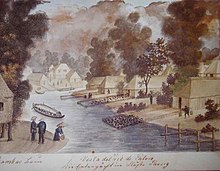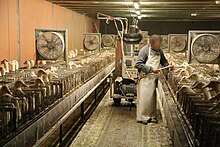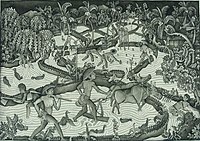Domestic duck
| Domestic duck | |
|---|---|
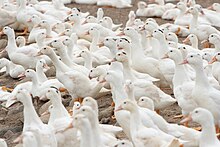
| |
| Farm in Taiwan | |
Domesticated
| |
| Scientific classification | |
| Domain: | Eukaryota |
| Kingdom: | Animalia |
| Phylum: | Chordata |
| Class: | Aves |
| Order: | Anseriformes |
| Family: | Anatidae |
| Genus: | Anas |
| Species: | |
| Subspecies: | A. p. domesticus
|
| Trinomial name | |
| Anas platyrhynchos domesticus | |
The domestic duck (Anas platyrhynchos domesticus) is a subspecies of
Duck farming is simplified by their reliable flocking behaviour, and their ability to forage effectively for themselves. Over 80% of global duck production is in China. Breeds such as
In culture, ducks feature in children's stories such as
Origins
Domestication
Domestic ducks appear from
Wild ducks were hunted extensively in Ancient Egypt and other parts of the world in ancient times, but were not domesticated. Ducks are documented in Ancient Rome from the second century BC, but descriptions – such as by Columella – suggest that ducks in Roman agriculture were tamed, not domesticated; there was no duck breeding in Roman times, so eggs from wild ducks were needed to start duck farms.[3]
Origins of breeds
Most
Other breeds are purely ornamental, having been selected for their crests, tufts, or striking plumage, for exhibition in competitions.[7]
A
-
White Pekinsare raised for meat.
-
Muscovy ducksproduce a richly-flavoured meat, and are kept as pets.
-
Indian Runner ducks stand upright, do not fly, and may produce over 300 eggs per year.[2]
Farming
Husbandry
Ducks have been farmed for thousands of years.
Ducks may lay some 200 eggs per year,
-
Painting by José Honorato Lozano of duck farms along the Pasig River in the Philippines, 1821
-
Turning duck eggs in front of incubators, Germany, 1952
-
Fattening ducks to produce foie gras, France, 2012
-
Duck farm in the Philippines, 2014
-
Inspecting duck eggs at a hatchery, Vietnam, 2014
Systems
In East and Southeast Asia, rice-duck farming is widely practised. This polyculture yields both rice and ducks from the same land; the ducks eat small pest animals in crop; they stir the water, limiting weeds, and manure the rice. Other polycultures in the region include rice-fish-duck and rice-fish-duck-azolla systems, where fish further manure the rice and help to control pests.[12][13]
Pests and diseases
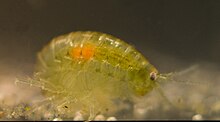
Domestic ducks have the advantage over other
Production
In 2021 approximately 4.3 billion ducks were slaughtered for meat worldwide, for a total yield of about 6.2 million tonnes;
As food
Meat
Since ancient times, the duck has been eaten as food.
Eggs and other products
In France, ducks are used for the production of
Duck eggs are eaten mainly in Asian countries such as China;[10]: 258 in the Philippines, balut – a fertilised duck egg at about 17 days of development, boiled and eaten with salt – is considered a delicacy and is sold as street food.[10]: 53
-
Duck eggs (left), larger and greener than chicken eggs (right) at market, Vietnam, 2022
-
Sichuan-style tea-smoked zhangcha duck
-
Duck liver pâté
In culture
For children

The domestic duck has appeared numerous times in children's stories.
The domestic duck features in the musical composition Peter and the Wolf, written by the Russian composer Sergei Prokofiev in 1936. The orchestra illustrates the children's story while the narrator tells it.[31] In this, a domestic duck and a little bird argue on each other's flight capabilities. The duck is represented by the oboe. The story ends with the wolf eating the duck alive, its quack heard from inside the wolf's belly.[32]
| The duck theme in Peter and the Wolf: Oboe |
|---|
![\relative c' { \clef treble \time 3/4 \set Staff.midiInstrument = #"oboe" \tempo "L'istesso tempo"4=92 \key aes \major \slashedGrace fes8( ees2.\mf->) | \slashedGrace ees8( d[ des c des] \slashedGrace d g[ f)] | \slashedGrace fes( ees2.->) }](http://upload.wikimedia.org/score/p/z/pzz89ag8b6itbx13c4u2oj06fmhw6ke/pzz89ag8.png) |
In art and folk culture
Domestic ducks are frequently depicted in wall paintings and grave objects from ancient Egypt.[33] They are featured in a range of ancient artefacts, which revealed that they were a fertility symbol.[34]
-
Tell el-Yahudiyeh Ware duck,
Egypt, c. 1700 BC -
Faience duck vase,
Egypt, 3rd century BC -
Pendant with duck's head,
England, c. 650 AD -
Edvard Munch's painting Jensen with Slaughtered Duck, 1912
-
Balinese traditional painting depicting a traditional paddy field with ducks foraging for food.
-
'The Big Duck', Long Island, New York: built on a duck farm, 1931
References
- ^ PMID 29635409.
- ^ ISBN 978-0-851-99667-7.
- ISBN 9783896466181.
- ISBN 978-0-521-08741-4.
- ^ DigiMorph Staff (2004). "Anas platyrhynchos, Domestic Duck". University of Texas at Austin. Archived from the original on 27 November 2016. Retrieved 23 December 2012.
- ISBN 978-9-400-95931-6.
- ^ "The best ducks to keep in your garden: in pictures". The Daily Telegraph. Retrieved 28 June 2017.
- ^ ISSN 0976-0555.
- ^ ISBN 978-981-16-6099-3.
- ^ ISBN 9780192115799.
- ^ "Ducks". Poultry Breeds Encyclopedia.
- ^ a b Bezemer, Marjolein (23 October 2022). "Mixed farming increases rice yield". reNature Foundation. Archived from the original on 11 October 2019. Retrieved 2 January 2024.
- ^ Furuno, Takao (2009). Traditional and modern matters on rice cultivation associated with duck. 6th International Rice–Duck Conference. Cebu, The Philippines. pp. 23–27.
- PMID 16704804.
- ^ Musa, Sharmin; Rahman, Tania; Khanum, Hamida (2012). "Prevalence and intensity of parasites in domestic ducks" (PDF). Dhaka University Journal of Biological Sciences. 21 (2): 197–199.
- .
- ^ a b Production Crops Livestock E All Area Groups NOFLAG (large download). Rome: Food and Agriculture Organization. Accessed June 2023. Lines 323–330.
- ^ Production Crops Livestock E All Data NOFLAG (large download). Rome: Food and Agriculture Organization. Accessed June 2023. Lines 10405–10406.
- ^ a b Duck and Goose from Farm to Table. Washington, DC: Food Safety and Inspection Service of the United States Department of Agriculture. Archived 20 September 2013.
- ISBN 978-1-135-95422-2.
- ISBN 978-2-764-40898-8.
- ISBN 978-0-191-01825-1.
- ^ "The Evolution of Peking Duck". CBS. 24 September 2006.
- ^ "A Cultural Classic: Peking Duck". Globe Trekker. Archived from the original on 17 May 2012. Retrieved 26 June 2017.
- ISBN 9780857836960.
- ISBN 9781909248557.
- ^ Roberts, Laura (16 December 2010). "The Tales of Beatrix Potter performed by The Royal Ballet". The Daily Telegraph. Archived from the original on 21 August 2016. Retrieved 26 June 2017.
- ISBN 9781854713858.
- ^ "Randolph Caldecott Medal". American Library Association. 2021. Retrieved 27 June 2023.
- ^ "Pekin Ducks". Oklahoma State University Extension - Department of Food & Animal Sciences. 20 July 2021. Retrieved 27 June 2023.
- ISBN 978-1-861-89489-2.
- ISBN 978-0-735-81189-8.
- ISBN 978-0-811-70706-0.
- ISBN 978-1-472-92287-8.
External links
![]() Media related to Anas platyrhynchos domesticus at Wikimedia Commons
Media related to Anas platyrhynchos domesticus at Wikimedia Commons
![]() Duck at the Wikibooks Cookbook subproject
Duck at the Wikibooks Cookbook subproject



![Indian Runner ducks stand upright, do not fly, and may produce over 300 eggs per year.[2]](http://upload.wikimedia.org/wikipedia/commons/thumb/0/09/Runner-ducks.jpg/180px-Runner-ducks.jpg)
